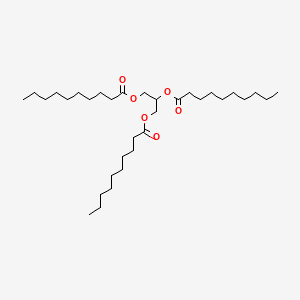| Authors | Title | Published | Journal | PubMed Link |
|---|---|---|---|---|
| Gautschi N et al. | Rapid determination of drug solubilization versus supersaturation in natural and digested lipids. | 2016 | Int J Pharm | pmid:27609663 |
| Suzuki A et al. | Tricaprin Rescues Myocardial Abnormality in a Mouse Model of Triglyceride Deposit Cardiomyovasculopathy. | 2018 | J Oleo Sci | pmid:30012901 |
| Satou C et al. | Modified Gas Chromatographic Method to Determine Monoacylglycerol and Diacylglycerol Contents in Edible Fats and Oils. | 2017 | J Oleo Sci | pmid:28515375 |
| Jin SE and Kim CK | Long-term stable cationic solid lipid nanoparticles for the enhanced intracellular delivery of SMAD3 antisense oligonucleotides in activated murine macrophages. | 2012 | J Pharm Pharm Sci | pmid:22974792 |
| Phan S et al. | Immobilised lipase for in vitro lipolysis experiments. | 2015 | J Pharm Sci | pmid:25630824 |
| Karabulut I et al. | Fatty acid selectivity of lipases during acidolysis reaction between oleic acid and monoacid triacylglycerols. | 2009 | J. Agric. Food Chem. | pmid:19835376 |
| Adam-Berret M et al. | Evolution of fat crystal network microstructure followed by NMR. | 2011 | J. Agric. Food Chem. | pmid:21314096 |
| Horowitz JF et al. | Preexercise medium-chain triglyceride ingestion does not alter muscle glycogen use during exercise. | 2000 | J. Appl. Physiol. | pmid:10642384 |
| Aisaka K and Terada O | Purification and properties of lipase from Rhizopus japonicus. | 1981 | J. Biochem. | pmid:7287641 |
| ErtuÄŸrul S et al. | Isolation of lipase producing Bacillus sp. from olive mill wastewater and improving its enzyme activity. | 2007 | J. Hazard. Mater. | pmid:17532131 |
Tricaprin
Tricaprin is a lipid of Glycerolipids (GL) class. The associated genes with Tricaprin are RHOQ gene. The related lipids are tricaproin and trilaurin.
Cross Reference
Introduction
To understand associated biological information of Tricaprin, we collected biological information of abnormalities, associated pathways, cellular/molecular locations, biological functions, related genes/proteins, lipids and common seen animal/experimental models with organized paragraphs from literatures.
What diseases are associated with Tricaprin?
There are no associated biomedical information in the current reference collection.
No disease MeSH terms mapped to the current reference collection.
PubChem Associated disorders and diseases
What pathways are associated with Tricaprin
There are no associated biomedical information in the current reference collection.
PubChem Biomolecular Interactions and Pathways
Link to PubChem Biomolecular Interactions and PathwaysWhat cellular locations are associated with Tricaprin?
There are no associated biomedical information in the current reference collection.
What functions are associated with Tricaprin?
There are no associated biomedical information in the current reference collection.
What lipids are associated with Tricaprin?
Related references are published most in these journals:
| Lipid concept | Cross reference | Weighted score | Related literatures |
|---|
What genes are associated with Tricaprin?
Related references are published most in these journals:
| Gene | Cross reference | Weighted score | Related literatures |
|---|
What common seen animal models are associated with Tricaprin?
There are no associated biomedical information in the current reference collection.
